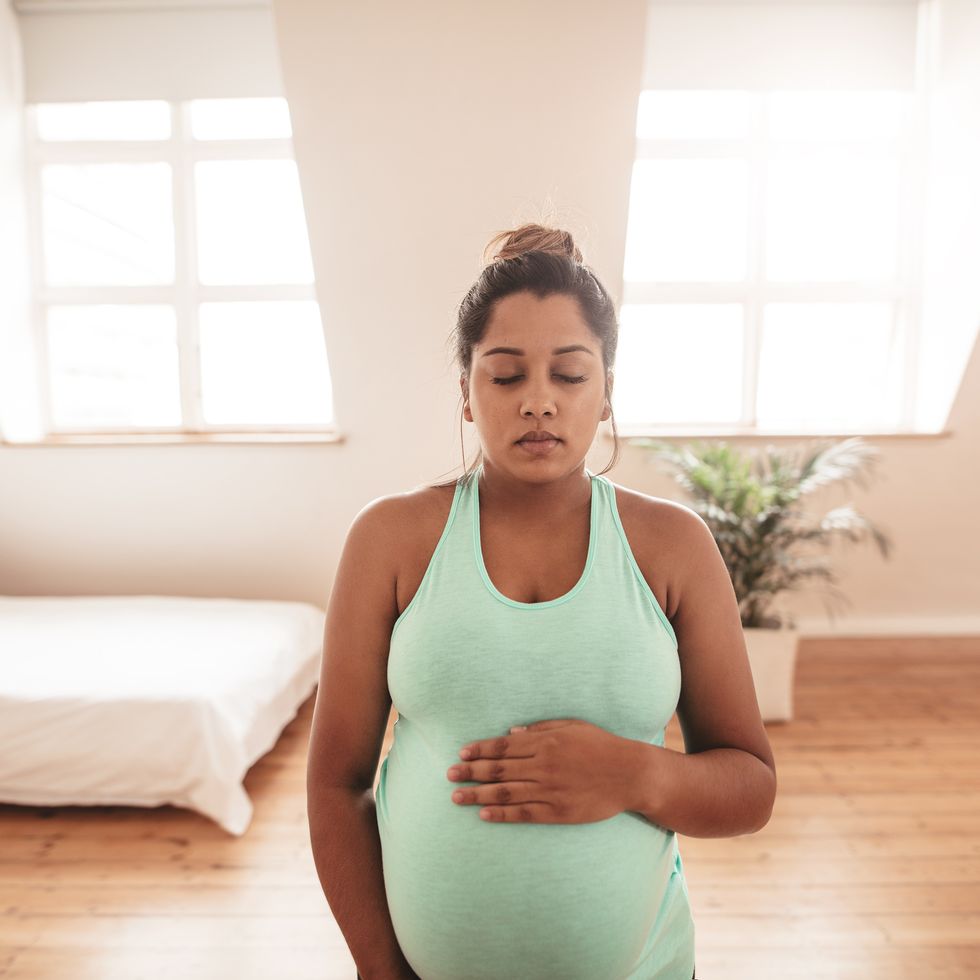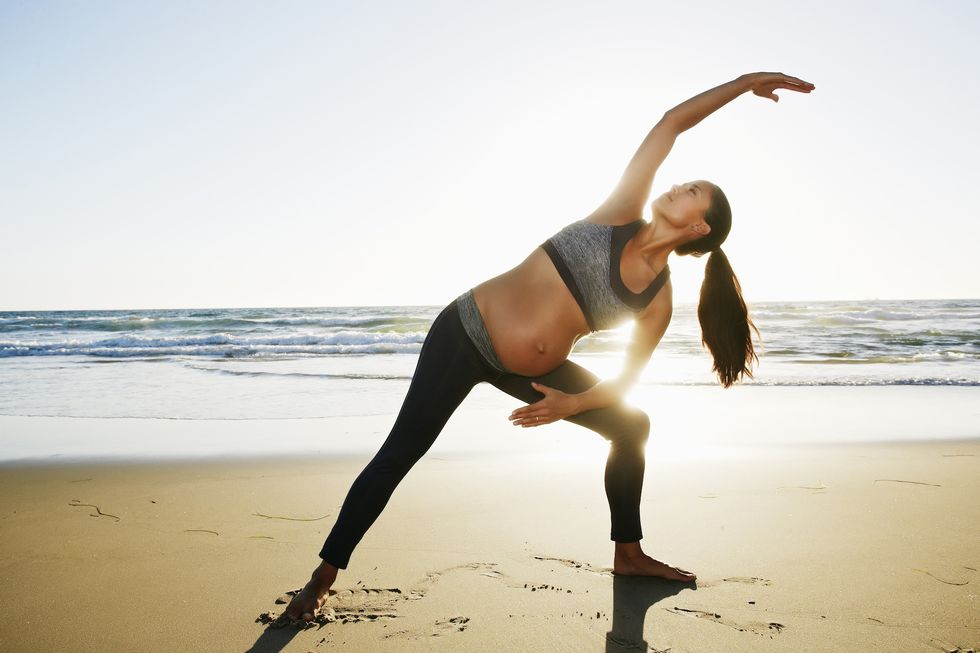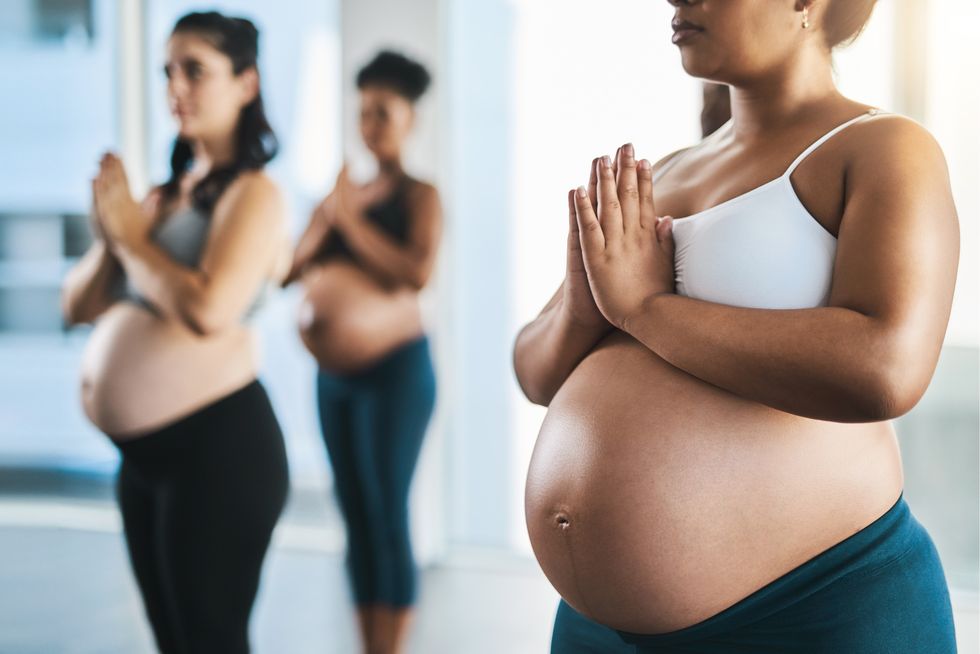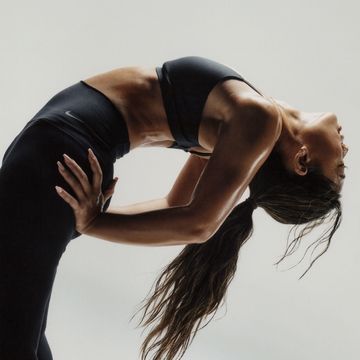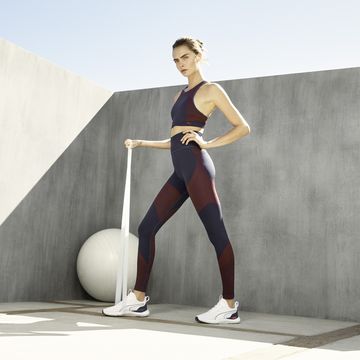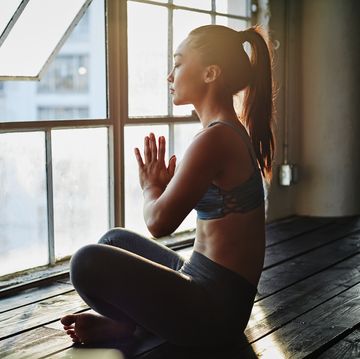‘Will my baby fall out when I’m running?’ ‘Why am I so bendy?’ ‘If I walk too fast will I dislodge the baby?’ These questions might sound fanciful, but they’re queries that cross a lot of women’s minds when it comes to pregnancy workouts.
Approaching exercise during pregnancy can be tricky because of all the information out there, a lot of which is contradictory. But working out when pregnant, no matter which trimester, doesn’t have to come from a place of fear or excessive restriction, especially if you’re someone who has always enjoyed exercise.
‘For most people, exercising when pregnant is safe,’ says Charlie Launder, founder of Bumps & Burpees who is currently expecting her first baby. ‘The caveat to every question asked about pregnancy is: everybody’s different. But unless you’ve been given a specific instruction by your doctor, consultant or midwife to say, “You should not exercise”, then it’s safe.’
What Are The Benefits Of Exercising While Pregnant?
The physical benefits of pregnancy exercise
Not only is it safe, but it’s actively encouraged. ‘Your body is going to be changing so much over the course of the pregnancy and you want to be putting it in the best possible position to accommodate those changes,’ explains Launder, who has been specialising in pre- and post-natal training for ten years.
‘The reason we suggest people should exercise is to stay strong and active and help to support the body through these changes.’
As well as staying strong and minimising aches and pains, ‘movement promotes healthy blood flow around the body’ says Launder. ‘And both you and your baby need that.’
Runner and master trainer at fiit Adrienne Herbert confirms this: 'Staying active throughout your pregnancy is proven to improve the health of both you and your baby. Benefits include improved cardiovascular function, maintaining a healthy body weight, and a reduced risk of developing gestational diabetes and gestational hypertension.'
The mental benefits of exercise during pregnancy
Working out when pregnant isn't just good for your body: ‘Pregnancy comes with a lot of uncertainty and things that are out of your control,’ explains Launder. ‘That could be really tough for people, especially if you were active before and you’re used to being in control of how your body feels and what it does. By keeping up exercise, you can maintain some sort of normality in your life: you’re still getting endorphins rushing through you, you’re doing something for you that you’re in control of.’
Amy Lane, digital editor of Women’s Health, who is expecting her first baby, couldn’t agree more: ‘Exercising during pregnancy helped me retain a sense of self. Pregnancy was always part of the plan, but when I had to start to live by a new set of rules, I did find this hard to stomach at times. But workouts and being active is what helps me feel good in my own skin. As someone who’s always enjoyed fitness, I want to show that it is possible to balance fitness with impending motherhood.’
Here are some tips on how to do just that.
Oh, and if you’re still wondering about whether the baby is OK when you’re out running or doing lunges, fear not.
‘The baby is very safe in there,’ Launder says. ‘In the first 15 weeks it is in the pelvis, so it’s actually protected by bone at that stage. You’re not going to dislodge the baby by doing too many lunges.’
Pregnancy exercises: Listening to your body & letting go of your ego
‘Your body tells you what you want to know, you just have to listen to it,’ says Charlie Launder.
We often push ourselves when working out, maybe because we’re being competitive or we're in a class environment where we’re being encouraged to work 110 per cent.
But pregnancy workouts are much more about working to 70 per cent of your capacity. One way to do this is to really start listening to your body.
‘If your body doesn’t like something, it will tell you as many ways as it can,’ Launder continues. ‘We’re very good at ignoring signs that our bodies give us. Pregnancy is when you have to learn when to listen. It’s worth constantly checking in with yourself: "Am I in control of this?" "Am I breathing properly?" Ask yourself those questions.’
Another way to achieve this is to let go of your ego. ‘It can be hardest for people who love exercise and have always done so, but it’s not a time for personal bests,’ explains Caroline Bragg, master trainer at Mumhood by Frame. ‘Rather, it’s a time for maintaining fitness, strengthening your body for what your next role is going to be – birth and then motherhood.’
Shifting your mindset when it comes to exercise in pregnancy can be one of the hardest things but, ‘once you’ve got that it’s much easier to not worry about your time exercising. As long as you’re moving and feeling good that’s the most important thing,’ adds Bragg.
Exercises you should avoid when pregnant
Before going into detail here, it’s important to remember that there’s more you can still do than things you can’t, according to Bumps & Burpees' Charlie Launder.
There are, however, a couple of things that are definitely off the cards.
Contact sports
‘You want to avoid any activity where you’ve got a really high risk of falling, or a high risk of someone falling into you, so contact sports, skiing, horse riding,’ says Launder. ‘These are obviously risks that you decide to take yourself, there are no rules as such about them.’
Overheating
Overheating is another thing to avoid. ‘The baby can’t maintain their own temperature; they go off your temperature and are always a few degrees warmer than you,’ says Launder. ‘So if you’re really hot, the baby is also going to be really hot: you want to make sure you’re not doing things like Bikram yoga or going into saunas, because that’s immediately overheating you and there’s no escape from that - there’s no air flow.’
Watch your heart rate
It’s also important to be mindful of your heart rate, but there’s no need to obsess over numbers. ‘In your first trimester your heart rate will be higher so you’ll find when you do something you found easy before – it will feel suddenly like tougher cardio. That’s just because your body is pumping more blood around and it’s busy, doing so much stuff,’ explains Launder.
Don’t worry if you don’t have a heart rate monitor or a fitness tracker to tell you your exact rate: ‘If you feel that you can’t catch your breath or that you couldn’t hold a conversation then that’s a sign to bring the level down a bit.'
How much exercise should I get during pregnancy?
Taking a breather in the most literal sense is important during pregnancy.
‘If you try and work out every day, each workout isn’t going to be great because you haven’t recovered and you’re tired, you’re not going to be performing where you want to be,’ says Launder. ‘Rest is important because your baby is taking all your energy.’
For someone who runs, she advises doing two strength sessions for every run you do and then for every strength session, having a rest. That means in one week you could do one run, two strength sessions, two rest days, and then a Pilates or a stretch.
Can I still work my core when pregnant?
This is one of the most common questions people ask trainers when they get pregnant. The answer depends largely on which trimester you’re in.
‘In your first trimester you can work your core and still do a plank and crunches – unless you’re someone who starts showing by eight weeks, which can happen,’ says Launder.
Her advice though is to try and think about what it is you’re working your core for? And no, it’s not a six-pack.
Adapting core exercises to suit you
‘You’re trying to get a strong, deep base in your core to support your bump. So holding a plank for 30 seconds might not actually be that effective for what you want. It might be better to do an exercise in the plank position, for example engaging your breath as you hold the position.’
After the first trimester, or from the time that the bump starts to show, Launder advises her clients to regress their core exercises: ‘So, start to drop to your knees in your plank (you can still make it a very long half plank), and for press ups too.
'When you do side planks, drop the bottom knee down and then control your core with your breathing – exhale on the effort and engage the core (basically, gently hug the baby into your spine on the hardest part of the exercise). This will make exercises more core efficient. You can make every single exercise a core exercise if you’re clever. ’
Avoid putting too much pressure on your core
As your bump grows, you want to avoid putting too much pressure on your core from the inside, and instead aim to protect and support it.
For Amy Lane, this was one of the biggest things she learnt about exercising when pregnant: ‘It wasn’t until I was 17 weeks pregnant (and a month into my second trimester) did I discover that you should exercise caution with core work. I’d gone into my pregnancy fit and strong and able to manage my body well during a plank, so I assumed that I could still do this. However, it wasn’t until I sought advice for “doming” [abdominal separation] that I learned that I’d been putting too much pressure on my midsection.’
Can you continue running throughout pregnancy?
'If you're an experienced runner, then you can continue to run throughout your pregnancy,' advises Adrienne Herbert, runner and master trainer at fiit.
'But bear in mind that during the first three months, you may feel low in energy, so ensure that you're getting enough rest and recovery. Aim for eight hours of sleep each night and don't worry too much about the pace, you're unlikely to run a new PB.'
Adapting your running workouts
If you're a regular runner, you may need to adapt your running plan. 'Remember to also incorporate some strength and conditioning exercises into your routine as well,' says Adrienne Herbert. 'This will help to support your back and upper body as your body changes throughout your pregnancy.'
Again, listening to your body is essential, which could mean slowing down your pace or walking for periods. As Amy Lane says, 'A 5K is still a 5K whether this is achieved with a run, jog, run-walk or plod.'
According to Adrienne, you may also need to reevaluate your kit: 'Make sure you have running shoes that support your gait, you may even need to go up half a shoe size. (During pregnancy the hormone relaxin causes the ligaments in your feet to relax so your feet will widen slightly.)'
Warming up and cooling down are also key to working out when pregnant: 'Before running, start off by doing some lying glute bridges and knee hugs to mobilise the hips and activate the glutes,' says Adrienne.
The importance of balance
As your bump grows, you may notice your centre of gravity changes, and you tend to feel more off balance.
For Caroline Bragg, master trainer at Mumhood by Frame, balance training is really important to do as part of pregnancy workouts. ‘Don’t shy away from movements where you’re unbalanced, but do choose safe exercise where you don’t risk falling.’
Exercises to help balance your bump
Bragg recommends a staggered deadlift where your back foot is slightly elevated so you’re off centre.
‘A lot of the stuff we teach at Mumhood are what we call "Mumhood moves" which replicate movements you might be doing when you have your baby. So you might do an offset squat where you have your weight on one side and lift something up with your other hand.’
In your third trimester, Bragg says even doing a lunge can make you feel quite off-centre. She would still recommend the movement to help with balance, but just take the number of reps down.
What are the benefits of yoga during pregnancy?
Ante-natal yoga is recommended in a lot of pregnancy books, but if you’ve never done yoga before, can it still be beneficial?
According to Annie Clarke, yoga teacher and founder of The Practice, an online portal for easily accessible yoga classes including pregnancy yoga, the benefits of yoga when pregnant can be felt at any stage, whether you’re a novice or a long-time yogi.
Those benefits aren’t just related to the physical elements of yoga either. ‘There are more subtle factors too - giving women an opportunity to connect to the fact that they’re going through this incredible journey. There’s so much changing in your body, and in your mind, in energy and hormones, that yoga gives you a chance to create a space where you can lean into that and find your breath.’
And while you might suddenly be way more flexible thanks to the higher levels of the hormone relaxin in your body, Clarke, who has recently launched a guide to optimal nutrition and mindful practices during pregnancy, recommends being careful of over stretching: ‘I think that’s one of the brilliant things about yoga is the awareness that it builds in our bodies so we can start to recognise signs if we’re going too deep with a stretch which can in turn lead to injury.’
On a positive note though, Clarke adds, it can make practising yoga while pregnant more interesting because you’ve got an added space and softness.
Yoga positions for pregnancy
Clarke’s pregnancy classes are open to anyone and suitable for all trimesters, but there are some moves she likes to focus on including supportive hip openings, like yogi squats, or malasana: ‘It’s about opening things up but also building strength to support that – you can develop both at once!’
Another great position is the goddess squat: ‘What I really like about that position is that you can pulsate while you’re in it, which means you’re working with the strength of the thighs and the glutes at the same time as opening up the hip. You can also do that with your breath.’
Gentle head and neck stretches are key to opening up the upper body and help with head and neck ache, a common complaint among her clients.
Cat and cow pose are also good for opening up the chest and upper back and easing tension in the neck: ‘you can do these without dipping too much into your lower back when moving into cow pose,’ says Clarke. So it becomes much more about opening the chest rather than lifting the tailbone.
These kinds of moves can help with one of the big changes pregnant bodies undergo: posture.
‘As the bump grows out the pelvis tilts forward and therefore you start standing in a way that makes you stick your bum out and lean back. That on its own can give you back ache, so it’s important to strengthen the muscles around these changes so that you can stand upright still without any pain,’ confirms Launder.
And finally...breathe
Another advantage of adding yoga to your pregnancy workouts is that it encourages tuning into your breath, something which, as Clarke points out, can be invaluable during labour.
However, don’t be fooled into thinking pregnancy yoga is just about sitting down and breathing for an hour and a half. ‘There’s a real balance to strike between safe movement, but also not forgoing the importance of the breath,’ says Clarke.
With all the advice out there, it's important to remember that building your strength while pregnant can give you a newfound respect for your body.
As Amy Lane of Women's Health says, 'I feel like I’m on a 10-month training plan; each day it deals with a new challenge or stress to keep making progress. My body knows exactly what it needs to do to reach the marathon of labour and that’s a little bit mind blowing.'
Like this article? Sign up to our newsletter to get more articles like this delivered straight to your inbox.
In need of more inspiration, thoughtful journalism and at-home beauty tips? Subscribe to ELLE's print magazine now and pay just £6 for 6 issues. SUBSCRIBE HERE


